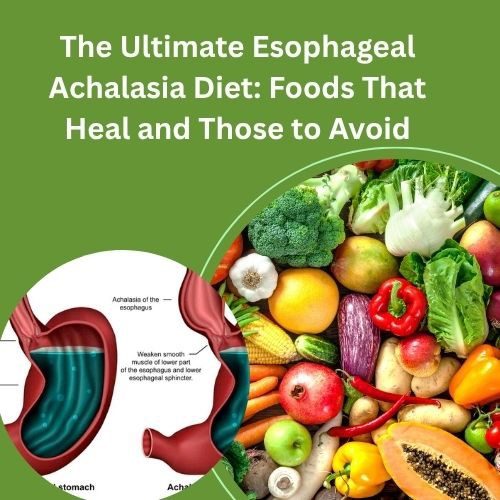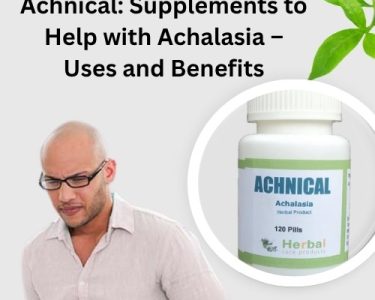Living with achalasia can make eating a challenge — but the right diet can make all the difference. The Esophageal Achalasia Diet focuses on choosing foods that ease swallowing, reduce discomfort, and support digestive health, while avoiding foods that can worsen symptoms.
If you or a loved one struggles with achalasia, this complete guide will help you understand what to eat, what to avoid, and how to structure your meals for better comfort and nutrition.
What Is Esophageal Achalasia?
Esophageal achalasia is a rare disorder where the lower esophageal sphincter (LES)—the muscular ring connecting the esophagus and stomach—fails to relax properly. This makes it difficult for food and liquids to pass into the stomach, often leading to symptoms like:
- Difficulty swallowing (especially solid foods)
- Regurgitation of food
- Chest pain or pressure
- Unintentional weight loss
- Heartburn or discomfort after eating
While there is no cure, Achalasia Natural Treatment and dietary management play a crucial role in easing symptoms and improving quality of life.
Why Diet Matters in Achalasia
The Esophageal Achalasia Diet helps minimize symptoms by focusing on:
- Easier swallowing — Choosing foods that are soft, smooth, and easy to digest.
- Reducing esophageal pressure — Avoiding foods that irritate or slow movement in the esophagus.
- Preventing malnutrition — Ensuring adequate nutrient intake despite eating difficulties.
- Enhancing digestion — Promoting foods that help move food gently into the stomach.
By eating the right foods in the right way, you can significantly reduce discomfort and improve your daily energy levels.
Key Principles of the Esophageal Achalasia Diet
Before diving into specific foods, here are the essential guidelines to follow:
- Eat smaller, more frequent meals – 5–6 small meals a day prevent overfilling the esophagus.
- Chew thoroughly – Chewing softens food, making it easier to pass through the LES.
- Drink plenty of fluids with meals – Sips of warm water or herbal tea help push food down.
- Avoid lying down right after eating – Stay upright for at least 1–2 hours post-meal.
- Experiment with textures – Some people tolerate liquids better, others prefer pureed or soft foods.
- Avoid extremes of temperature – Very hot or cold foods can worsen spasms.
Related Article: Achalasia Diet: Top Foods to Eat for Better Swallowing
Best Foods for the Esophageal Achalasia Diet
The goal is to include foods that are soft, smooth, nutrient-dense, and easy to swallow. Below are food groups and examples to build your achalasia-friendly meal plan.
- Smooth and Pureed Foods
These foods are gentle on the esophagus and reduce choking or regurgitation risks.
- Mashed potatoes or sweet potatoes
- Pureed soups (e.g., pumpkin, carrot, lentil)
- Smooth oatmeal or cream of wheat
- Applesauce
- Pureed vegetables and fruits
- Smooth nut butters (in small quantities)
Tip: Avoid chunky soups or foods with large pieces — blend them to a smooth consistency.
- Soft Proteins
Protein is crucial for maintaining muscle strength and preventing malnutrition. Choose tender, moist sources that are easy to chew.
- Poached or scrambled eggs
- Soft fish (tilapia, cod, salmon)
- Ground chicken or turkey
- Tofu and paneer
- Protein smoothies (with milk alternatives if tolerated)
Avoid: Fried or tough meats, as they can stick in the esophagus.
- Cooked Vegetables
Raw vegetables can be too fibrous and difficult to swallow. Instead, eat well-cooked or pureed versions.
- Steamed carrots, zucchini, spinach, or pumpkin
- Mashed cauliflower or potatoes
- Vegetable purees and soups
Tip: Add olive oil or broth to make vegetables smoother and easier to swallow.
- Soft Fruits
Soft, ripe, or blended fruits provide vitamins and fiber without irritating the esophagus.
- Bananas
- Ripe peaches or pears (without skin)
- Watermelon
- Papaya
- Stewed apples or fruit compote
- Smoothies made with blended fruits and yogurt
Avoid: Citrus fruits and raw apples, as they can be acidic and tough to swallow.
- Whole Grains (Softened)
Whole grains are important for fiber and sustained energy, but make sure they’re cooked until very soft.
- Oatmeal or porridge
- Softened rice or rice pudding
- Quinoa (well-cooked)
- Soft whole grain bread (without crusts)
Avoid: Dry cereals, crusty bread, or crackers that can get stuck in the throat.
- Healthy Fats
Fats can lubricate the esophagus and add calories, helping to maintain a healthy weight.
- Olive oil or avocado oil
- Avocados (mashed)
- Nut butters (smooth, not chunky)
- Full-fat yogurt or soft cheese (if tolerated)
Avoid: Fried foods or heavy creams that can worsen reflux.
- Liquids and Smooth Beverages
Liquids are generally easier to swallow and help move solid foods down.
- Warm water (especially before and during meals)
- Broths and soups
- Herbal teas (chamomile, ginger)
- Protein shakes
- Smoothies (without seeds or ice chunks)
Avoid: Carbonated drinks, alcohol, and caffeine as they can irritate the LES.
Foods to Avoid in the Esophageal Achalasia Diet
Certain foods can aggravate symptoms by tightening the LES, increasing reflux, or being hard to swallow. Avoiding these can greatly improve comfort.
- Tough or Dry Foods
These are the most likely to get stuck in the esophagus.
- Tough cuts of meat (steak, lamb)
- Dry chicken or turkey
- Toast, crackers, and dry bread
- Chips or crisps
- 2. Spicy and Acidic Foods
These can irritate the esophageal lining and worsen pain or heartburn.
- Chili peppers
- Tomato-based sauces
- Vinegar and pickles
- Citrus fruits (oranges, lemons, grapefruit)
- Fatty or Fried Foods
These slow digestion and increase pressure on the LES, worsening reflux.
- Fried snacks
- Creamy sauces
- Butter-heavy meals
- Fast food and processed meats
- Carbonated and Caffeinated Beverages
Gas and caffeine both contribute to bloating and LES irritation.
- Soda or sparkling water
- Coffee and strong tea
- Alcohol (especially wine and beer)
- 5. Very Hot or Very Cold Foods
Extreme temperatures can cause esophageal spasms.
- Ice-cold drinks
- Very hot soups or beverages
Opt for lukewarm or room-temperature foods instead.
Sample Meal Plan for the Esophageal Achalasia Diet
Here’s a sample daily meal plan to help you visualize what an ideal achalasia-friendly day looks like:
Breakfast
- Warm oatmeal made with almond milk
- Mashed banana or applesauce on the side
- Herbal tea (chamomile or ginger)
Mid-Morning Snack
- Smoothie with blended papaya, yogurt, and honey
Lunch
- Pureed vegetable soup (pumpkin or carrot)
- Soft fish or scrambled eggs
- Mashed sweet potato with olive oil
Afternoon Snack
- Soft fruit (e.g., ripe pear) or a protein shake
Dinner
- Steamed or pureed vegetables (zucchini, spinach)
- Ground chicken in light broth
- Rice pudding or soft porridge for dessert
Before Bed
- Warm water or herbal tea
Helpful Eating Tips for Achalasia Patients
Even with the best diet, how you eat matters as much as what you eat. Try these daily strategies to reduce discomfort:
- Sit upright while eating and for 1–2 hours afterward.
- Take small bites and chew slowly until the food is almost liquid.
- Avoid eating before bedtime. Leave at least 3 hours between your last meal and sleep.
- Elevate your head during sleep using extra pillows to prevent regurgitation.
- Keep a food diary to identify which foods cause symptoms or are easier to tolerate.
Special Considerations: Post-Treatment or Surgery Diet
If you’ve undergone achalasia surgery (like Heller myotomy or pneumatic dilation), you’ll likely follow a special recovery diet. Typically, this includes:
- Liquid diet (first few days): Broths, juices, and protein shakes.
- Pureed diet (next week): Blended soups, yogurt, mashed vegetables.
- Soft diet (after 1–2 weeks): Soft grains, fish, and tender meats.
Always follow your doctor’s specific instructions during recovery and reintroduce foods gradually.
Hydration and Achalasia
Dehydration can worsen swallowing difficulties. Aim for at least 6–8 glasses of fluids daily, choosing soothing options like:
- Warm water
- Diluted fruit juices (non-acidic)
- Broth-based soups
Avoid sugary sodas or fizzy drinks that cause bloating.
Supplements and Nutritional Support
If you’re struggling to maintain weight or nutrition, consider these with your doctor’s approval:
- Protein powders or meal replacement shakes
- Multivitamins for overall support
- Calcium and vitamin D if dairy intake is limited
- Omega-3 supplements to reduce inflammation
Lifestyle Tips for Managing Achalasia Along with Diet
Diet is only part of managing achalasia. Combine it with these lifestyle adjustments for better symptom control:
- Stay active – Gentle walks aid digestion.
- Manage stress – Stress can worsen esophageal spasms. Practice deep breathing or meditation.
- Avoid smoking – Nicotine weakens the LES muscle.
- Maintain healthy weight – Excess weight can increase abdominal pressure.
When to Seek Medical Help
Even with a perfect Esophageal Achalasia Diet, some symptoms may persist or worsen. Contact your healthcare provider if you experience:
- Severe chest pain or pressure
- Rapid weight loss
- Difficulty swallowing even liquids
- Vomiting undigested food
You may need medical procedures or medication to relax the esophagus or widen the LES.
Final Thoughts
The Esophageal Achalasia Diet isn’t just about avoiding difficult foods — it’s about finding comfort, balance, and nourishment despite the condition. By focusing on soft, smooth, and nutrient-rich meals, staying hydrated, and eating mindfully, you can minimize discomfort and regain control over your eating habits.




